![]()
![]()
![]()
Use LEFT and RIGHT arrow keys to navigate between flashcards;
Use UP and DOWN arrow keys to flip the card;
H to show hint;
A reads text to speech;
130 Cards in this Set
- Front
- Back
- 3rd side (hint)
|
What is anatomy?
|
The study of the structure of the body parts and their relationship to one another
|
|
|
|
What are the three "areas" of anatomy?
|
1. Gross or macroscopic
2. Microscopic 3. Developmental |
|
|
|
What is physiology?
|
The study of the function of the body's structural machinery
|
|
|
|
What are the three areas of gross anatomy and briefly explain each
|
1. Regional - all structure in 1 part of they body
2. Systemic - studied by the system 3. Surface - internal structure as they relat to the skin |
|
|
|
What are the two areas of microscopic anatomy?
|
1. cyctology - cells
2. histolgy - tissue |
|
|
|
What is developmental anatomy?
|
Structural changes through life: embryology - the body before birth
|
|
|
|
Name 3 speacialized branches of anatomy
|
1. Pathological - changes by diseases
2. Radiographic - xrays, etc 3. Molecular - subcellular level |
|
|
|
If you are studying the operation of the renal system, you are studying what?
|
kidney function
|
|
|
|
What is neurophysiology?
|
study of the nervous system
|
|
|
|
What is the study of the cardiovascular system?
|
operation of the heart and blood vessels
|
|
|
|
In physiology, physics help to explain what?
|
1. electrical currents
2. blood pressure 3. the way muscle uses bone for movement |
|
|
|
What is the idea of "complementarity"?
|
Function always reflects structure
|
|
|
|
List the structural organization of the body
See Slide 11 |
1. chemical
2. cellular 3. tissue 4. organ 5. organ system 6. organismal |
|
|
|
What is the integumentary system composed of?
|
skin, sweat, glands, hair, nails (external body covering)
|
|
|
|
What is the purpose of the integumentary system?
|
to protect deep tissues from injury
synthesized vitamin D |
|
|
|
What is the skeletal system composed of?
|
bone, cartilage, ligaments
|
|
|
|
What is the function of the skeletal system?
|
protecs and supports organs, provides framework for muscles
|
|
|
|
Where is the site of blood cell formation?
|
skeletal system
|
|
|
|
What is the muscular system composed of?
|
muscle, tendons
|
|
|
|
What helps us to maintain posture and also produces heat?
|
muscular system
|
|
|
|
What is the nervous systems composed of?
|
brain, spinal column and nerves
|
|
|
|
When the nervous system responds to stimuli, what does it do?
|
activates muscles and glands
|
|
|
|
What is the cardiovascular system composed of ?
|
heart, blood vessels
|
|
|
|
What is the lymphatic system composed of?
|
red bone marrow, thymus, spleen, lymph nodes, lymphatic vessels
|
|
|
|
What is the function of the lymphatic system?
|
picks up fluid leaked from blood vessels AND disposes of debris in the lymphatic stream (also housed white blood cells)
|
|
|
|
What is the respiratory system composed of ?
|
nasal cavity, pharynx, trachea, bronchi, lungs
|
|
|
|
What is the function of the respiratory system?
|
keeps blood supplied with oxygen and removes CO2
|
|
|
|
What is the digestive system composed of?
|
oral cavity, esophagus, stomach, sm intestine, lrg intestine, rectum, anus, liver
|
|
|
|
What is the urinary system composed of?
|
kidney, ureters, urinary bladder, urethra
|
|
|
|
What does the male reproductive system compose of?
|
prostate gland, penis, testes, scrotum, ductus deferens
|
|
|
|
What is the femal reproductive system composed of?
|
mammary glands, ovaries, uterine tubes, uterus, vagina
|
|
|
|
Picture of "organ system interrelationships"
|

Picture of "organ system interrelationships"
|
|
|
|
How do our bodies keep "separate" internal and external environments at both the CELLULAR and ORGANISMAL level?
|
cellular - plasma membranes
organismal - skin |
|
|
|
List several "necessary" life functions
|
responsiveness, digestions, metabolism, excretion, movement, reproduction, growth
|
|
|
|
List 5 things our body needs to survive
|
nutrients, oxygen, water, normal body temp, atmospheric pressure
|
|
|
|
What is homeostasis?
|
maintaining a stable internal environment
|
|
|
|
List the three interdependen components of the homeostatic control mechanism
|
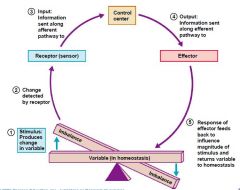
1. receptor: monitors and responds to changes
2. control center: determines point the variable is maintained 3. effector: means to respond to stimuli |
|
|
|
Diagram of "negative feedback" (i.e regulation of room temp)
See Slide 46 |
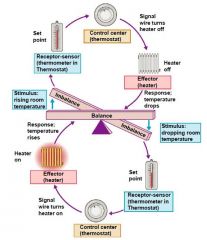
Diagram of "negative feedback" (i.e regulation of room temp)
See Slide 46 |
|
|
|
What happens in a "positive feedback" system?
|
the output enchances or exaggerates the original stimulus
|
|
|
|
Illustration of a "positive feedback" system (i.e. blood clotting)
See Slide 59 |
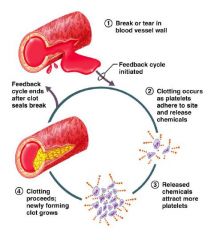
Illustration of a "positive feedback" system (i.e. blood clotting)
See Slide 59 |
|
|
|
What is homeostatic imbalance?
|
a disturbance of homeostasis or disturbance in the body's normal equilibrium
|
|
|
|
What is the anatomicaly correct position
|
body erect
feet apart palms facing forward thumbs away from body |
|
|
|
Directional term: superior?
|
Toward the head-end - upper part of the body
|
D
|
|
|
Directional term: inferior?
|
Away from the head-end - lower part of the body
|
|
|
|
Directional term: anterior?
|
toward or at front of the body
|
|
|
|
Directional term: posterior?
|
toward or at the back of the body
|
|
|
|
Directional term: medial?
|
middle - midline of the body
|
|
|
|
Directional term: lateral?
|
AWAY from the midline of the body
|
|
|
|
Directional term: intermediate?
|
between a more medial and lateral structure
|
|
|
|
Directional term: proximal?
|
CLOSER TO the origin of the body part (i.e the elbow is proximal to the wrist)
|
|
|
|
Directional term: distal?
|
FARTHER FROM the origin of the body (i.e the knee is distal to the thigh)
|
|
|
|
Directional term: superficial?
|
toward or at the body surface (i.e skin is superfical to the skeletal muscle)
|
|
|
|
Directional term: deep?
|
away from the body surface (i.e lungs are deep to the skin)
|
|
|
|
nose
|
nasal
|
|
|
|
mouth
|
oral
|
|
|
|
neck
|
cervical
|
|
|
|
shoulder point
|
acromial
|
|
|
|
armpit
|
axillary
|
|
|
|
abdomen
|
abdominal
|
|
|
|
arm
|
brachial
|
|
|
|
front elbow
|
antecubital
|
|
|
|
forearm
|
antebrachial
|
|
|
|
pelvis
|
pelvic
|
|
|
|
wrist
|
carpal
|
|
|
|
thumb
|
pollex
|
|
|
|
palm
|
palmar
|
|
|
|
fingers
|
digital
|
|
|
|
genital region
|
pubic
|
|
|
|
anterior knee
|
patellar
|
|
|
|
leg
|
crural
|
|
|
|
ankle
|
tarsal
|
|
|
|
toes
|
digital
|
|
|
|
foot
|
pedal
|
|
|
|
forehead
|
frontal
|
|
|
|
eye
|
orbital
|
|
|
|
cheek
|
buccal
|
|
|
|
chin
|
mental
|
|
|
|
breastbone
|
sternal
|
|
|
|
chest
|
thoracic
|
|
|
|
breast
|
mammary
|
|
|
|
navel
|
umbilical
|
|
|
|
hip
|
coxal
|
|
|
|
groin
|
inguinal
|
|
|
|
thigh
|
femoral
|
|
|
|
side of leg
|
fibular
|
|
|
|
big toe
|
hallux
|
|
|
|
head
|
cephalic
|
|
|
|
hand
|
manus
|
|
|
|
ear
|
otic
|
|
|
|
base of skull
|
occipital
|
|
|
|
spinal column
|
vertebral
|
|
|
|
shoulder blade
|
scapular
|
|
|
|
arm
|
brachial
|
|
|
|
back
|
dorsal
|
|
|
|
loin
|
lumbar
|
|
|
|
between hips
|
sacral
|
|
|
|
between anus and genital
|
perineal
|
|
|
|
thigh
|
femoral
|
|
|
|
back of knee
|
popliteal
|
|
|
|
calf
|
sural
|
|
|
|
heel
|
calcaneal
|
|
|
|
sole
|
plantar
|
|
|
|
Body plane: sagittal?
|
divides body into left and right parts
|
|
|
|
Body plane: midsagittal (medial)?
|
the midline of the sagittal (litteral, the middle section of the body cut directly in half)
|
|
|
|
Body plane: frontal (coronal)?
|
divides body into front and back
|
|
|
|
Body plane: transverse(horizontal)
|
divides body into upper half (head, chest) and lower half (abdomen, legs)
|
|
|
|
Body planes: oblique section?
|
diagonal cuts
|
|
|
|
What percentage of anatomical structures match textbook descriptions? What accounts for the 10% difference?
|
90%
vessels may be somewhat out of place and some small muscles may be missing |
|
|
|
Extreme anatomical variations are quite common. T or F?
|
False
|
|
|
|
How many cavities are in the body, and what are they?
|
2
Dorsal and Ventral |
|
|
|
What are the two cavities WITHIN the dorsal cavity?
|
cranial cavity and vertebral cavity
|
|
|
|
What is the purpose of the dorsal cavity?
|
to protect the neverous system
|
|
|
|
What is inside the cranial cavity?
|
the brain (inside the skull)
|
|
|
|
What is inside the vertebral cavity?
|
the spinal cord (insdie the vertebral column
|
|
|
|
What is contained in the ventral cavity?
|
Internal organs (viscera)
|
|
|
|
The ventral cavity is divided into the subdivisions. What are they?
|
thoracic and abdominopelvic
|
|
|
|
Illustration of body cavities
|
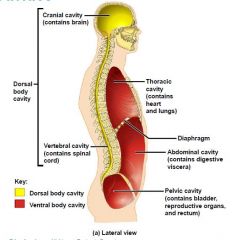
|
Illustration of body cavities
|
|
|
Illustration of body cavities
|
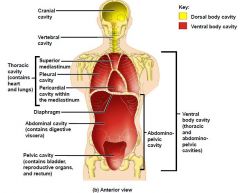
|
Illustration of body cavities
|
|
|
What is inside the thoracic cavity?
|
heart and lungs
|
|
|
|
What are the three subdivisions of the thoracic cavity and what is inside each one?
|
1. pleural: each has a lung
2. pericardial: the heart 3. mediastinum: surrounds remaining thoracic organs |
|
|
|
What is it that separates the thoracic cavity from the abdominopelvic area?
|
diaphragm (dome-shapped)
|
|
|
|
The abdominopelvic cavity contains what two subdivisions?
|
1. abdominal cavity
2. pelvic cavity |
|
|
|
What is found in the abdominal cavity?
|
stomach, intestines, spleen, liver, etc
|
|
|
|
What is found in the pelvic cavity?
|
bladder, reproductive organs, rectum
|
|
|

This image is much like ventral body cavity MEMBRANE. Explain each part
|
Parietal Serosa - lines the internal body wall
Visceral Serosa - covers the internal organs Hand - acting as the organ Serous Fluid - inbetween outer and inner walls (the "air" of the ballon) |
|
|
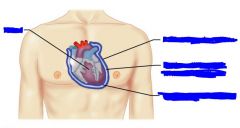
Identify each section of the heart serosae
|

Identify each section of the heart serosae
|
|
|
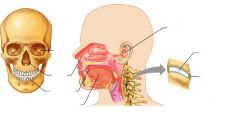
Identify these additional body cavities
|

Identify these additional body cavities
|
|
|
|
Name the 9 abdominopelvic regions (from top to bottom, left to right)
|
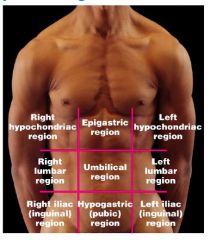
Good Job!!
|
|
|
|
Name the 12 organs in the abdominopelvic area
|
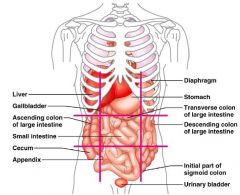
Good job !
|
|
|
|
The abdominopelvic area can be broken up into quadrants. T or F?
|
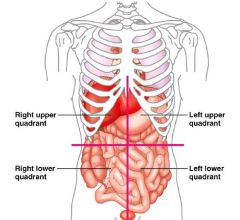
True
|
|

